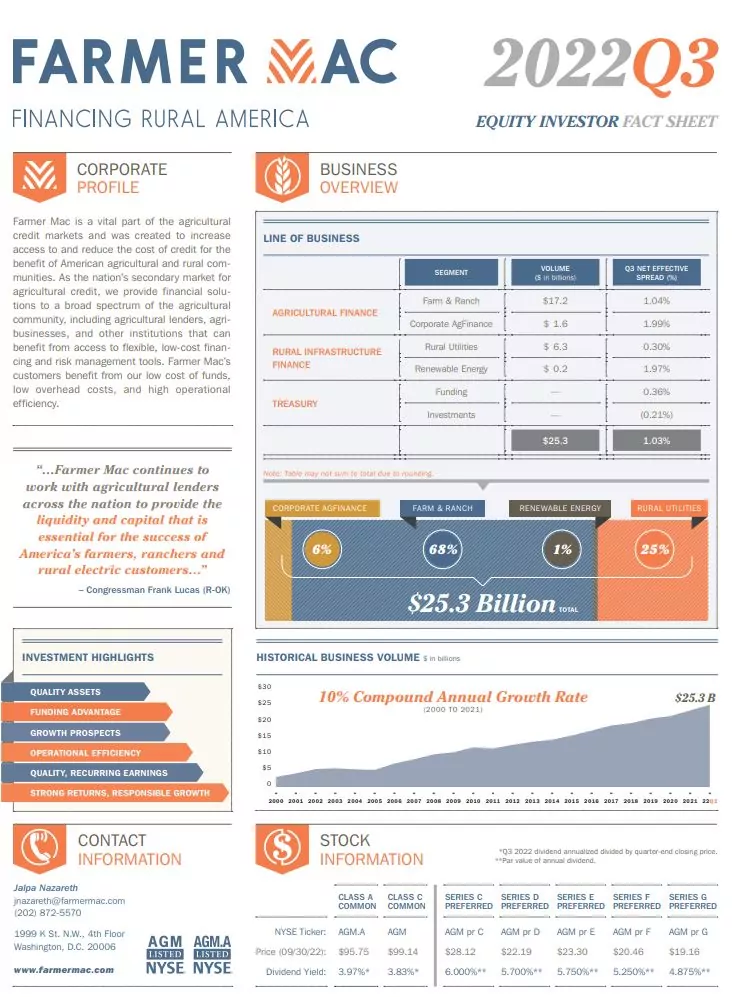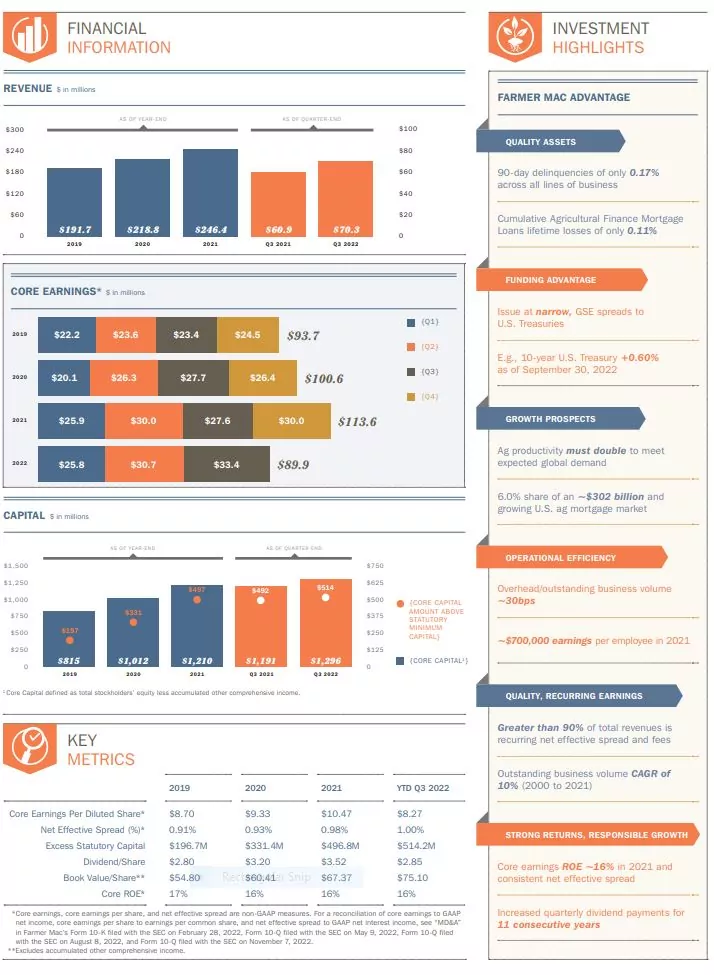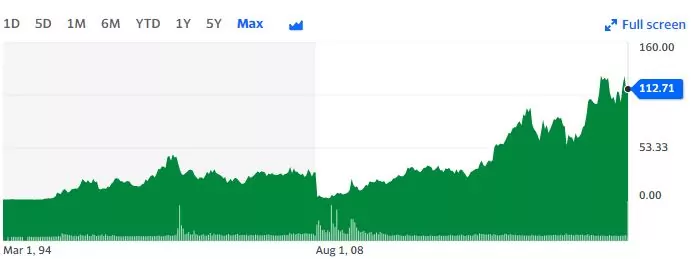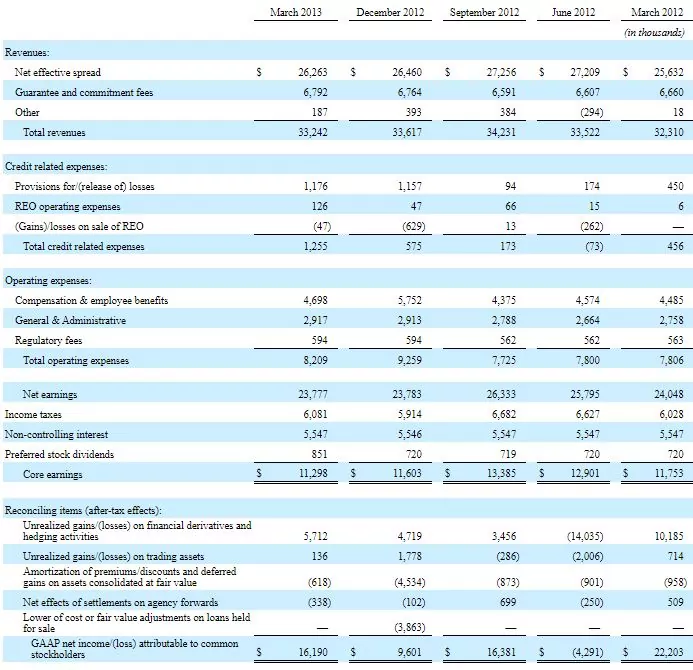The Federal Agricultural Mortgage Corporation (AGM), also known as Farmer Mac, is a relatively large lender, primarily to the rural agricultural sector in the United States. This includes rural utilities (such as cooperatives like the one that supplies my electricity on the south side of the Twin Cities). Farmer Mac is not a primary lender, but only acts in the secondary market providing liquidity to the primary lenders. For instance the Farm Credit System members are primary lenders and work directly with farmers and ranchers.
I am reviewing this one because I mentioned this one this week and others have mentioned it and own some of their preferred shares. The company has 5 preferred issues currently outstanding with coupons from 4.875% to 6%, current yields from 5.08% to 6.93% (the 5.08% current yield is a fixed to floating rate issue). Yields to 1st optional call ranges from a -7% to 17%.
Here is Farmer Mac’s own description of their business–
Farmer Mac is a vital part of the agricultural credit markets and was created to increase access to and reduce the cost of capital for the benefit of American agriculture and rural communities. As the nation’s premier secondary market for agricultural credit, we provide financial solutions to a broad spectrum of the agricultural community, including agricultural lenders, agribusinesses, and other institutions that can benefit from access to flexible, low-cost financing and risk management tools. Farmer Mac‘s customers benefit from our low cost of funds, low overhead costs, and high operational efficiency. In fact, we are often able to provide the lowest cost of borrowing to agricultural and rural borrowers. For more than a quarter-century, Farmer Mac has been delivering the capital and commitment rural America deserves.
The company was chartered by congress in 1987 and was publicly listed in 1999–so they have been around for 35 years–not new, but also not old as these things go. While they are a government sponsored entity, the federal government doesn’t guarantee that they pay their debts or dividends so no one should be lured into thinking this makes a dividend payment or preferred share price bulletproof (witness Fannie Mae back in the financial crisis days).
The company has chosen not to have their preferred shares rated, but a review of their financials shows they are superior to virtually every other lender.
Below is a ‘fact sheet’ on the company. I realize the print is small but below the sheets I have a link to the original source document.
Note that they have sustained losses over the years of just .11% on over $35 billion of loan volume. Additionally they have not ever sustained a loss in the Rural Utilities, USDA or Institutional lines of credit businesses. Currently they have .17% 90 day delinquency rate–compare that to any other lender out there and you will find this is excellent–just for comparison sake I compared against U.S. Bank (USB) who I consider an excellent lender. USB has a rate of .11% (excluding non performing loans) or .30% including non performing loans.


The original source document is here.
Below I have posted the consolidated statement of operations for the quarter ending 9/30/2022. Note that the net income has grown very nicely from the year ago quarter and year ago 9 month period. Look at the provision for loan losses–virtually NONE on a book of loans of around $25 billion.

As you review this operating statement you might note that the absolute level of net income is not huge for their book of business (loans). I think that is a fair observation–but AGM can borrow very cheaply and the loans they make are at very fair rates. The company only deals in 1st mortgage loans and they target loan to values between 40 and 50%—this is very conservative which greatly contributes to their loan loss ratio. Additionally when there are defaults on loans AGM rarely takes a loss because of the equity present in the mortgaged property.
So what about the performance of AGM on a longer time frame? Below is a chart for AGM which goes to company inception. You can see that the largest credit losses the company has ever had was in 2006 and it appears that the credit losses were about $10 million–almost a rounding error in their large book of business.

Now because most of us like to review the common share performance as a metric when considering purchasing preferred shares–how has the common done. We can see that the common shares traded all the way down to the $2.50 area in 2008–that is pretty scary. We know that we had the financial crisis then and that Freddie and Fannie Mac went belly up (essentially as they are still operating under a conservativeship to this day). What about Farmer Mac?

Normally I would simply go back to the 10-K (annual report to SEC) or quarterly 10-Q reports to find out what happened back then. But alas the SEC edgar system only goes back to 2013 for AGM and from the 2013 reports I can get back to data from 3/2011. Below are quarterly financials back to 3/2011–I have divided it into 2 pages in my attempt to make it legible.
We can see that they certainly had some challenging quarters and with their thin margins disruptions can take a toll. The provisions for loan losses were reasonable numbers–but as a percentage higher than they currently are at. On a GAAP basis adding in unrealized losses of hedging operations they sustained a couple quarterly losses–but no annual losses in 2011 and 2012. All in all, considering the financial crisis, these financials are somewhat acceptable. So why was the stock price $2.50 or so in 2008?


So I am without financials statements prior to 2011 so a Google search will have to do.
So here is what I find. In 2008 Farmer Mac held preferred shares in Fannie Mae and additionally they had exposure to Lehman Brothers. Because of these huge losses AGM had a capital ‘crisis’ in which the Farm Credit System Banks and Zion Bancorporation stepped in with a $65 million capital infusion.
A Forbes article from 2008 is here–
Farmer Mac’s Amber Waves Of Pain
Additionally there is another Forbes article titled “Farmer Mac Mowed Down by Fannie’ about this same time–I am unable to access this article.
In October, 2008 the congressional research service published a report specifically about the Farmer Mac capital issue. The report is here.
The bottom line is that Fannie Mae and Lehman Brothers caused a capital crisis at Farmer Mac–shares plunged in 2008 to the $2.50 area from the $30 area when the Fannie crisis started.
So do events from 14-15 years ago have relevance to today? I think that history tells us that we have to have our eyes and ears open all of the time and watch for systemic events. To think that one government sponsored entity would nearly start the dominos tumbling to other government sponsored entities likely was not considered likely at the time–but now we KNOW. As ‘knowledgeable investors’ we MUST pay attention to systemic risk where ever it might be.
While AGM has not suffered operating losses–this shows how investment losses and loss of capital can almost sink a lender.
Disclosure–I took a nibble on the AGM-F 5.25% perpetual preferred last week. I may add more soon, although it is undecided.

